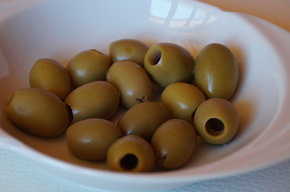Researchers from the U.S. FDA developed a novel method to separately extract lipophilic and hydrophilic Cu-CDP and quantify Cu-CDP by UHPLC combined with inductively coupled plasma isotope dilution mass spectrometry (UHPLC-ICP-ID-MS)
Background:

Table olives are a popular food and green colorization is a key feature in the perception of freshness. However, during industrial processing and storage the green color of newly harvested olives fades to pale yellow as a result of reactions degrading the chlorophyll. The re-greening of table olives may be achieved by complexation of chloro-phyll degradation products (CDP) with Cu
2+, to form stable bright green copper CDP (Cu-CDP) complexes.
Known coloring substances are the lipophilic food color E141i composed of Cu-CDP and the hydrophilic food color E141ii including sodium copper chlorophyllin besides other Cu compounds. However, both coloring substances are not allowed in the EU for the production of table olives. Unfortunately, the detection of E141ii in green table olives and other foods proved challenging. Major obstacles are the poor extraction efficiency from foods containing high fat content and the lack of reliable reference materials.
The new study:Researchers from the U.S. FDA explored the possibilities to quantify Cu-CDP by using ultra-high-performance liquid chromatography with inductively coupled plasma isotope dilution mass spectrometry.
Lipophilic and hydrophilic Cu-CDP complexes were extracted from olives by dedicated liquid extraction procedures. The different complexes were identified by UHPLC-high resolution mass spectrometry (UHPLC-HRMS). For quantification, UHPLC-ICP-S with post culumn unspecific isotope dilution was applied. This technique can quantify Cu-CDP without species-specific calibration standards, does not suffer from calibration drift or matrix effects and is a more accurate approach than traditional external calibration strategies. Both types of complexes were quantified separately by UHPLC-ICP-ID-MS.
The content of total elemental Cu and individual Cu-CDP was used to evaluate how the bright green coloration of table olives was achieved. Twenty four samples of bright green and pale yellow table olives sold in the US ere analysed in this way. Pale yellow olives contained < 1 mg/kg lipophilic Cu-CDP and < 3.5 mg/kg total elemental Cu. Bright green table olives contained 4–22 mg/kg lipophilic Cu-CDP and 14.4–161 mg/kg total elemental Cu in contrast to < 6 mg/kg reported for natural abundance, indicating the formation of Cu-CDP was achieved by addition of copper salts.
The developed methodology seems to be useful for food control which is required to ensure the complete food safety and the compliance with the current law.
 The original study:
The original study:

Bhakti Petigara Harp, Peter F. Scholl, Patrick J. Gray, Pierluigi Delmonte,
Quantitation of copper chlorophylls in green table olives by ultra-high-performance liquid chromatography with inductively coupled plasma isotope dilution mass spectrometry, J. Chromatogr. A, 1620 (2020) 461008. DOI: 10.1016/j.chroma.2020.461008
 Used techniques and instrumentation:
Used techniques and instrumentation:
 Agilent Technologies Inc. - 8800 - Triple Quad ICP-MS
Agilent Technologies Inc. - 8800 - Triple Quad ICP-MS
 Agilent Technologies Inc. - Series 1100 HPLC
Agilent Technologies Inc. - Series 1100 HPLC
 Related studies (newest first)
Related studies (newest first)

C. Negro, L. De Bellis, E. Sabella, E. Nutricati, A. Luvisi, A. Micelli,
Detection of not allowed food-coloring additives (copper chlorophyllin-copper sulfate) in green table olives sold on the Italian market, Adv. Hort. Sci., 31/4 (2017) 225–233.
DOI: 10.13128/ahs-20814 
R. Aparicio-Ruiz, K.M. Riedl, S.J. Schwartz,
Identification and quantification of metallo–chlorophyll complexes in bright green table olives by high-performance liquid chromatrography–mass spectrometry quadrupole/time-of-flight, J. Agric. Food Chem. 59/20 (2011) 11100–11108.
DOI: 10.1021/jf201643s M.F. Giné
M.F. Giné, A.P. Packer,
Online isotope dilution and inductively coupled plasma mass spectrometry: from elemental to species quantification, J. Braz. Chem. Soc. 21 (2010) 575–589.
DOI: 10.1590/s0103-50532010000400002
Y. Sahan, F. Basoglu, S. Gucer, I
CP-MS analysis of a series of metals in black and green olive samples from Bursa, Turkey, Food Chem. 105 (2007) 395–399.
DOI: 10.1016/j.foodchem.2006.12.026
A. Mortensen, A. Geppel,
HPLC–MS analysis of the green food colorant sodium copper chlorophyllin, Innov. Food Sci. Emerg. Technol., 8/3) (2007) 419–425.
DOI: 10.1016/j.ifset.2007.03.018 D. Schaumlöffel, R. Łobinski
D. Schaumlöffel, R. Łobinski,
Isotope dilution technique for quantitative analysis of endogenous trace element species in biological systems, Int. J. Mass Spectrom., 242/2 (2005) 217–223.
DOI: 10.1016/j.ijms.2004.11.020
M.J. Scotter, L. Castle, D. Roberts,
Method development and HPLC analysis of retail foods and beverages for copper chlorophyll (E141[i]) and chlorophyllin (E141[ii]) food colouring materials, Food Additives Contam., 22/12 (2005) 1163–1175.
DOI: 10.1080/02652030500306885 K.G. Heumann
K.G. Heumann, L. Rottmann, J. Vogl,
Isotope-dilution ICP–MS for trace element determination and speciation: from a reference method to a routine method, Anal. Bioanal. Chem., 378/2 (2004) 318–329.
DOI: 10.1007/s00216-003-2325-z

L. Rottmann,
K.G. Heumann, Determination of heavy metal interactions with dissolved organic materials in natural aquatic systems by coupling a high-performance liquid chromatography system with an inductively coupled plasma mass spectrometer, Anal. Chem., 66/21 (1994) 3709–3715.
DOI: 10.1021/ac00093a027
L. Rottmann,
K.G Heumann,
Development of an on-line isotope dilution technique with HPLC/ICP-MS for the accurate determination of elemental species, Fresenius’ J. Anal. Chem., 350/4-5 (1994) 221–227.
DOI: 10.1007/BF00322473
M.I. Mínguez-Mosquera, L. Gallardo-Guerrero, D. Hornero-Mendez, J. Garrido-Fernandez, I
nvolvement of copper and zinc ions in green staining of table olives of the variety gordal, J. Food Protect., 58/5 (1994) 564–569.
DOI: 10.4315/0362-028X-58.5.564 K.G. Heumann
K.G. Heumann, L. Rottmann, J. Vogl,
Elemental speciation with liquid chromatography–inductively coupled plasma isotope dilution mass spectrometry, J. Anal. Atom. Spectrom., 9/12 (1994) 1351–1355.
DOI: 10.1039/JA9940901351 Related EVISA Resources
Related EVISA Resources
 Link database: Toxicity of copper species
Link database: Toxicity of copper species  Brief summary: Speciation Analysis - Striving for Quality
Brief summary: Speciation Analysis - Striving for Quality  Related EVISA News:
Related EVISA News:
last time modified: July 12, 2020